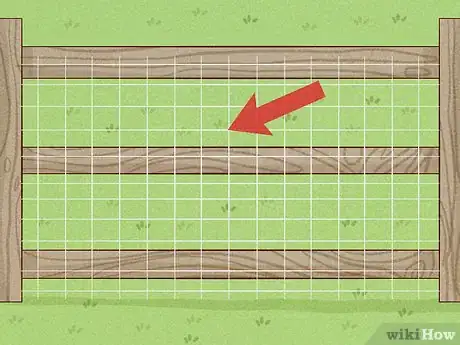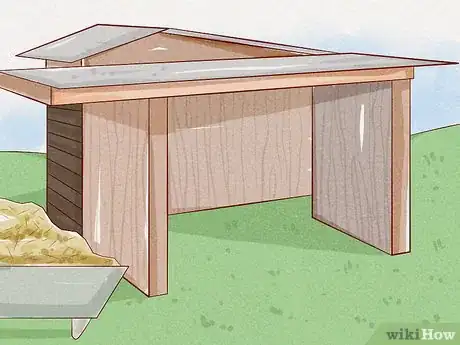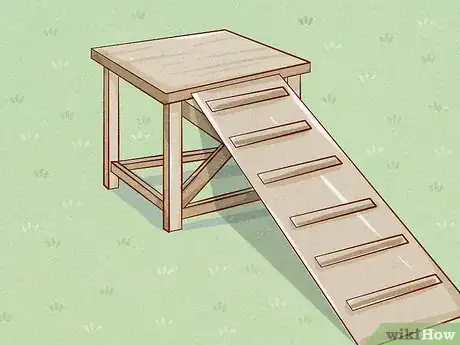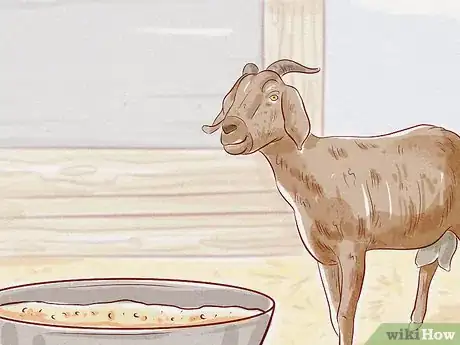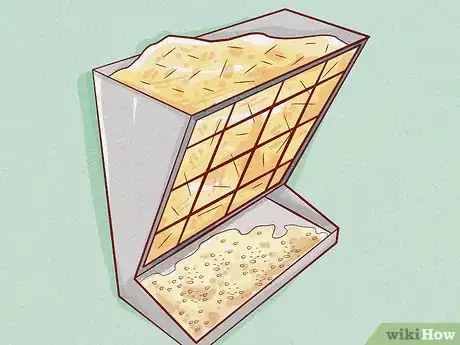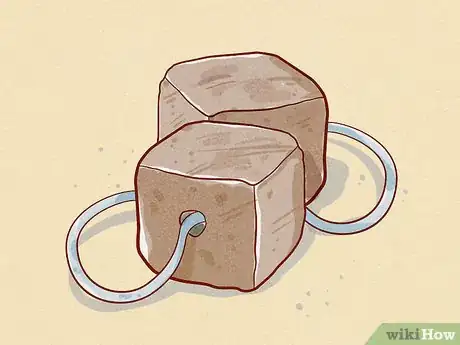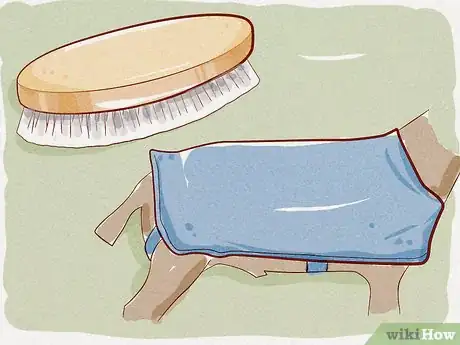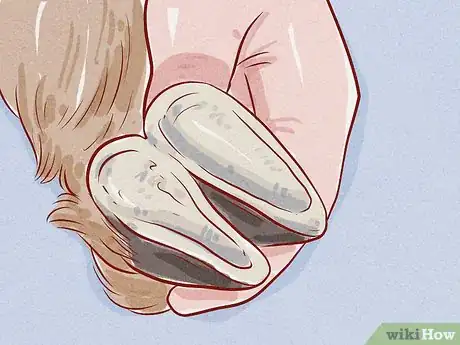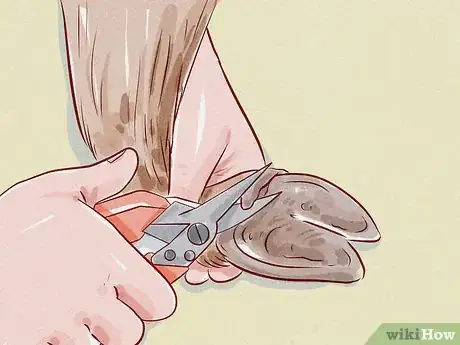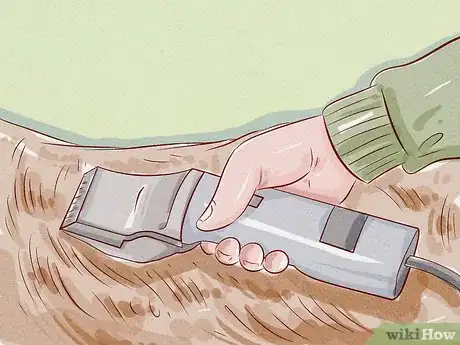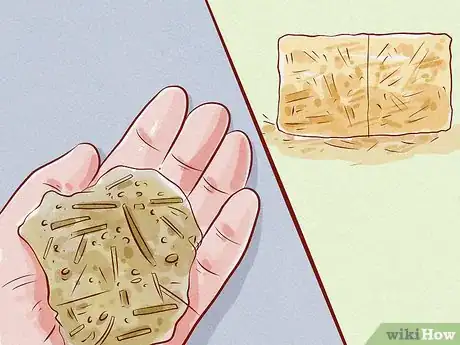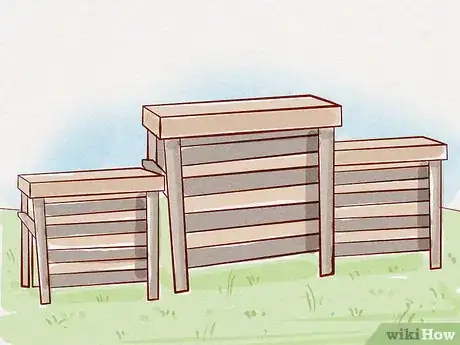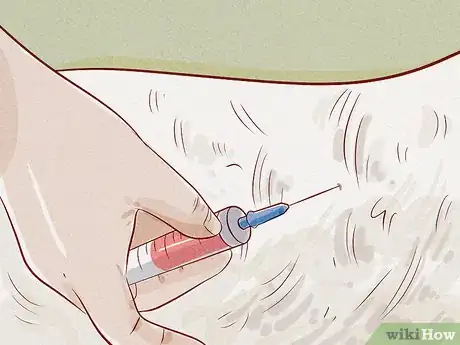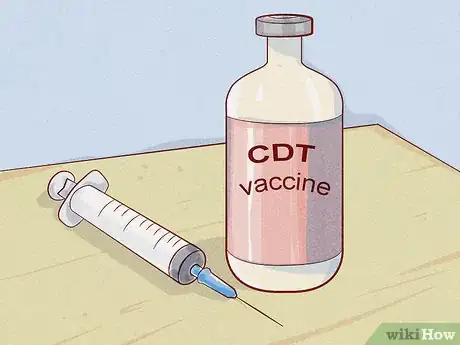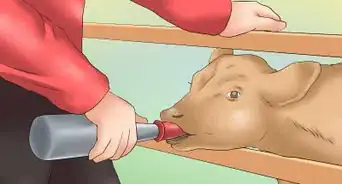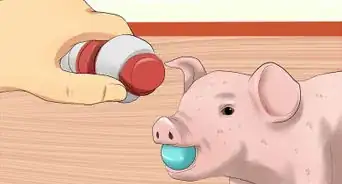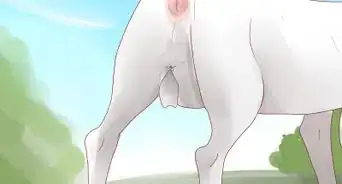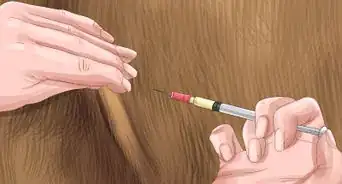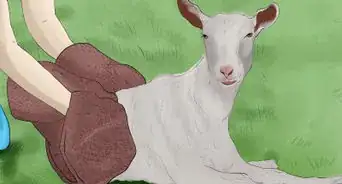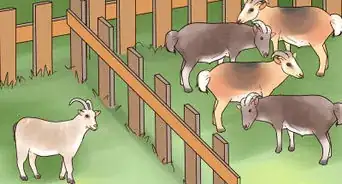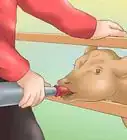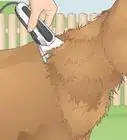This article was co-authored by Ryan Corrigan, LVT, VTS-EVN and by wikiHow staff writer, Danielle Blinka, MA, MPA. Ryan Corrigan is a Licensed Veterinary Technician in California. She received her Bachelor of Science in Veterinary Technology from Purdue University in 2010. She is also a Member of the Academy of Equine Veterinary Nursing Technicians since 2011.
There are 10 references cited in this article, which can be found at the bottom of the page.
wikiHow marks an article as reader-approved once it receives enough positive feedback. This article received 13 testimonials and 91% of readers who voted found it helpful, earning it our reader-approved status.
This article has been viewed 215,021 times.
Goats are smart, curious pets that are fun to have around. However, they can also be hard work. If not cared for properly, they can get aggressive and may try to escape to greener pastures -- literally. Luckily, you can make your goat a happy family member by creating a safe home for them, feeding them properly, grooming them, and keeping them healthy.
Steps
Creating a Safe Home
-
1Set aside a pasture. Your pasture should be large enough to accommodate your goat, a shelter, and entertainment features, such as large rocks for the goat to climb on. Your goat will forage for food in its pasture, so giving it more space will allow for more grazing. Goats like to eat plants, including weeds, grass, and bushes, so your goat pasture should have a lot of vegetation.
- Goats forage for food and will eat whatever is in their pasture. Make sure everything growing in your pasture is non-toxic.
- Goats love weeds, so don’t pull them. Your goat will enjoy munching on them.[1]
- Ideally, you should provide up to an acre of pasture or more to allow for foraging. If your lot is smaller, you will need to supplement your goat's diet with hay and pellets. [2]
- If you have just 2-4 small breed goats, 20 square meters could be enough if you supplement their diet.
-
2Install a strong fence around the pasture. Your fence should not only keep the goat in, it should also keep predators out. Goats are smart and can climb, so they commonly escape from their pen. The fence should be high and difficult to climb, measuring at least 6 feet high. Some goat owners choose to install an electric fence, which provides an extra deterrent to escape.
- You can construct a sturdy fence by installing heavy wood posts deep into the ground. Then anchor them with concrete. Secure the fence with livestock fencing, choosing the small mesh over the large.[3]
- Keep any enrichment items away from the fence so your goats don’t escape.
- Your goat is less likely to try to escape if it has lots of space, plenty of food, a nice shelter, and entertainment.[4]
Advertisement -
3Build a shelter for the goat. At the minimum, your goat will need a 3-sided shelter that faces the south, which helps protect it from wind. The goat will rely on the shelter to protect it from the elements, especially rain and heat. The shelter should be well ventilated but free from drafts. Place straw bedding inside the shelter so that the goat is comfortable.[5]
- Goats can live in a small shed or large dog house.
- You may choose to install a concrete floor in the shelter, which is easy to maintain. However, it’s also expensive and should be covered with a soft straw bedding.
-
4Provide entertainment for your goat. Goats are very intelligent, and a bored goat will go looking for trouble. Entertainment could include large rocks, a ramp to climb on, or recycled barrels. The goat will enjoy climbing on the items, as well as butting its head against them.[6]
- Make sure that whatever you place in the goat’s pen is sturdy and free of things that could harm the goat, such as protruding nails.
- Use toys and treats to keep your goat’s mind active.
Feeding Your Goat
-
1Provide fresh water. Your goat needs access to fresh water at all times. Use a heavy watering container, as goats can turn them over. You should check the water at least twice a day, more during extreme temperatures.[7]
- During winter, you may need to provide water throughout the day if the temperature drops below freezing. You can also purchase a freeze-proof watering device from a livestock store.[8]
-
2Provide your goat with plenty vegetation to graze. This could include grass, weeds, brush, vining plants, and other greenery. Goats can even eat prickly vegetation like briars! If your pasture doesn’t have a lot of variety, you may consider spreading seeds for common weeds like dandelion. Plant shrubs along the fenceline, as goats prefer to graze there. You can also bring the goat cuttings from yummy plants.[9] It’s best to provide your goat with a mix of the following:
- Grasses
- Weeds
- Vining plants
- Ivy
- Thistle
- Brambles
- Nettles
-
3Keep your goat away from poisonous plants. Goats may have a reputation for being able to eat anything, but there are plants that can harm a goat. Although goats are able to sniff out dangerous plants, they’re also curious and may munch on them anyway. Make sure that these plants don’t grow in or near your pasture, and avoid supplying cuttings of them to your goat. Common plants that are poisonous to goats include:
- Rhododendrons
- Milkweed
- Azaleas
- Yew
- Oleander
- Delphinium
- Lily-of-the-valley
- Larkspur
- Wild cherry
- Buckthorn
- Lilac
- Daffodil
- Laurel
- Poppy
- Rhubarb
- Tomato
-
4Supplement grazing with hay and other grains. Goats don’t require grains in their diet, but they will enjoy munching on them. Grains are also a great food choice during winter or if your pasture is too small to accommodate grazing alone.[10] Feed the goat grains like hay, oats, bran, and barley.
- Goats normally eat 3-4% of their body weight each day.[11] You will need to base your goat's feed supply on the weight of the goat.
- You only need to supplement your goat's diet if it doesn't have enough foraging material to eat. You may also want to supplement a dam before breeding or a goat that you are fattening up for slaughter.
- You can also find feed pellets for goats, which are nutrient dense. You can provide these as an alternative to grains.
- Feed them extra food during the winter, as this will help them withstand lower temperatures.[12] For example, you may feed them up to 4% of their body weight in grains if the goat cannot forage.
-
5Hang your feeders off of the ground. Although they love to graze, goats don’t like to eat their feed from off the ground. Keeping the food off the ground reduces the chance of mold, as well as prevents insects from eating or infesting it. When you are supplying them with food, such as hay, it’s best to mount it on the wall of the shelter or on a fence post.
- Feeders used for horses are a good option.
- If you have more than one goat, choose a wide feeder. The goats may try to push each other out of the way, and a narrow feeder can result in injury.[13]
-
6Get a vet recommended salt lick supplement. Goats need a variety of vitamins and minerals in their diet, but the quality of their diet can depend on soil quality and what you feed them. In many cases, they will need a supplement. Many owners choose a salt mix or salt lick that contains the needed mineral(s). This way the goat will happily eat the supplement, and they’ll drink more water, as well!
- Your vet can tell you which blend will work best for your goat, as the quality of the soil in your region will determine which blend of minerals you need. They can also tell you how much of the salt lick supplement you should provide to your goat and how often.
- You can purchase your goat’s salt mix or salt lick at a livestock store or online.
- Make sure that extra supplement is stored away from the goats, as they may eat more than they’re supposed to if they can.[14]
Grooming Your Goat
-
1Brush out its coat daily. First, use a hard brush to break up and remove any caked on mud and dirt. Then, run a comb through the goat’s coat to remove any remaining particles. Finally, run a soft brush over the goat to create a shiny coat. As you do this, run your hands along the goat’s body to make sure that you don’t feel any lumps or bumps that could indicate a possible illness or injury.[15]
- If you do feel anything abnormal or if your goat’s demeanor has changed, call the vet immediately.
-
2Inspect your goat’s hooves daily. Keep your goat’s hooves as dry as possible. During the daily brushing, check the goat’s hooves for damage or items that may get stuck in them, such as rocks or dirt. Remove anything that you see and make sure that the hoof looks good. If you notice any foul odors or signs of damage, call your vet immediately.
-
3Cut your goat’s hooves. Your goat can't run, jump, and climb happily without healthy hooves. Unfortunately, too much cutting and too little cutting can both make your goat lame. Have a professional show you how to cut your goat’s hooves, as well as the right size for the hooves. Once your goat’s hooves are properly cut, you’ll need to trim them every 6-8 weeks to maintain that length.[18]
- If you don’t feel comfortable cutting the goat’s hooves, get a professional to do it. It’s far better to pay the professional every time rather than risk harming your goat.
-
4Trim your goat's coat if necessary. Use a pair of electric clippers to trim the goat’s coat. During cooler weather, this may include trimming around the udders, belly, tail, and thighs to keep it neat. During summer, you may choose to trim the goat’s coat shorter so that it’s more comfortable.[19]
- If you’re new to using the clippers, start with just a small area until you get the hang of it. It’s also a good idea to have someone who is experienced show you how to use them.
- Don’t clip near the goat’s eyes, ears, or sensitive areas until you know how to use the clippers safely.
- There is no minimum length for a goat's coat, but you should consider the weather in your area. It's not a good idea to clip the goat's hair short if the weather may cool down.
Keeping Your Goat Healthy
-
1Remove manure and soiled bedding daily. Scoop out poop and wet, stinky bedding every day. This includes in the pasture and in the goat’s shelter. Replace the bedding with fresh hay.
- This will prevent your goat from becoming ill since you’re removing the parasites that live in the manure.
- Once or twice a year, you should do a deep cleaning of your goat’s shelter. Remove the bedding and scrub down all surfaces. Then replace the bedding with fresh hay.
-
2Exercise your goat. Goats are active animals, so make sure your goat gets lots of exercise. Encourage your goat to climb by placing things to climb on in their pasture, such as large rocks, wooden structures, and bushes. You can also run and play with your goat.
- If your pasture is on the smaller side, take the goat on a walk.
- Goats also enjoy items like a seesaw, which allows them to run up and down it to try to balance it.
-
3Ask your vet about the "BoSe" shot. The BoSe shot contains Selenium and Vitamin E, which your goat needs to stay healthy. They’re especially important for muscle, bone, and reproductive health. Since many goats are deficient in these important minerals, the shot is usually administered to goats once yearly.
- Since it’s only available through the vet, you’ll need a prescription for the shot.
- If you’re breeding your goat(s), it’s a good idea to give them the shot before breeding season. It helps the kid develop properly and protects the dam from complications.
-
4Vaccinate your goat annually. Goats should be given the CDT vaccine, which protects against Clostridium perfringens type C and D, as well as tetanus. The vaccine’s effect wanes over time, so you must administer a booster yearly.
- If the goats are breeding, bucks should be given their booster 30 days before breeding season, while dams should get their shot 30 days before kidding. Baby goats should be first vaccinated at 5-6 weeks and then again 3-4 weeks later.[20]
- You can also vaccinate the goat against rabies if your vet recommends it. Rabies vaccinations are not standard in goats.[21]
-
5Deworm your goat only after consulting with a vet. Goats can get internal parasites, such as worms, so deworming is helpful. Since there are few dewormers formulated for goats, you’ll likely need to use one made for sheep, cattle, or horses. You’ll need to adjust the dosage based on the size of your goat, which is why you should talk to your vet first.
- If you breed your goats, deworm your dam just after she gives birth, which protects both mother and babies, as the dewormer passes through the mother’s milk.[22]
- Young kids should receive their first deworming between 6-8 weeks of age.
- You can also use this dewormer chart for goats: https://ahdc.vet.cornell.edu/programs/NYSCHAP/docs/GoatDewormerChart.pdf
-
6Watch for bloating. Goats can bloat for several reasons, such as overeating, eating an imbalance of foods, or eating something poisonous. In any case, it can be dangerous. If you notice that your goat’s belly is bigger, rounder, and harder than it was the day before, call your vet to get it examined.
- You may also notice that the goat’s belly is distended or that the goat is having trouble walking. The goat may also be gassy.
- It's best to consult your vet before trying to treat your goat. An example treatment consists of drenching a pint of mineral oil or cooking oil down the goat's throat, and then walking and massaging the goat until it releases the gas. Then mix 1 tablespoon (15 ml) of sodium bicarbonate into 1 cup (240 ml) of water or molasses. Feed this to the goat.[23]
- Bloating can be very harmful to your goat, so get it treated immediately.
Expert Q&A
-
QuestionWhat should I do if the goat has a bladder infection?
 Ryan Corrigan, LVT, VTS-EVNRyan Corrigan is a Licensed Veterinary Technician in California. She received her Bachelor of Science in Veterinary Technology from Purdue University in 2010. She is also a Member of the Academy of Equine Veterinary Nursing Technicians since 2011.
Ryan Corrigan, LVT, VTS-EVNRyan Corrigan is a Licensed Veterinary Technician in California. She received her Bachelor of Science in Veterinary Technology from Purdue University in 2010. She is also a Member of the Academy of Equine Veterinary Nursing Technicians since 2011.
Licensed Veterinary Technician Have your goat diagnosed by a veterinarian. They should put it on antibiotics.
Have your goat diagnosed by a veterinarian. They should put it on antibiotics. -
QuestionCan a goat live happily with dogs?
 Ryan Corrigan, LVT, VTS-EVNRyan Corrigan is a Licensed Veterinary Technician in California. She received her Bachelor of Science in Veterinary Technology from Purdue University in 2010. She is also a Member of the Academy of Equine Veterinary Nursing Technicians since 2011.
Ryan Corrigan, LVT, VTS-EVNRyan Corrigan is a Licensed Veterinary Technician in California. She received her Bachelor of Science in Veterinary Technology from Purdue University in 2010. She is also a Member of the Academy of Equine Veterinary Nursing Technicians since 2011.
Licensed Veterinary Technician Yes with the right dogs. You need to introduce them slowly and make sure they all get alone safely first, otherwise keep them separated if the dog shows any aggression.
Yes with the right dogs. You need to introduce them slowly and make sure they all get alone safely first, otherwise keep them separated if the dog shows any aggression. -
QuestionHow old should a goat be when I buy it?
 Ryan Corrigan, LVT, VTS-EVNRyan Corrigan is a Licensed Veterinary Technician in California. She received her Bachelor of Science in Veterinary Technology from Purdue University in 2010. She is also a Member of the Academy of Equine Veterinary Nursing Technicians since 2011.
Ryan Corrigan, LVT, VTS-EVNRyan Corrigan is a Licensed Veterinary Technician in California. She received her Bachelor of Science in Veterinary Technology from Purdue University in 2010. She is also a Member of the Academy of Equine Veterinary Nursing Technicians since 2011.
Licensed Veterinary Technician A middle-aged adult goat that's about 3 or 4 years old would make a great pet.
A middle-aged adult goat that's about 3 or 4 years old would make a great pet.
Warnings
- Many ornamental plants, like azaleas, are poisonous to goats. Make sure that the plants you provide are safe for your goat.⧼thumbs_response⧽
References
- ↑ https://www.hobbyfarms.com/how-to-raise-goats-on-pasture/
- ↑ http://livestocktrail.illinois.edu/sheepnet/paperDisplay.cfm?ContentID=9808
- ↑ https://morningchores.com/goat-fencing/
- ↑ https://www.hobbyfarms.com/how-to-raise-goats-on-pasture/
- ↑ https://extension.unh.edu/resources/files/Resource000471_Rep493.pdf
- ↑ https://www.hobbyfarms.com/how-to-raise-goats-on-pasture/
- ↑ https://www.hobbyfarms.com/how-to-raise-goats-on-pasture/
- ↑ https://extension.unh.edu/resources/files/Resource000471_Rep493.pdf
- ↑ https://www.hobbyfarms.com/how-to-raise-goats-on-pasture/
- ↑ https://www.hobbyfarms.com/how-to-raise-goats-on-pasture/
- ↑ https://www.gov.mb.ca/agriculture/livestock/production/goat/pubs/goats-and-their-nutrition.pdf
- ↑ https://extension.unh.edu/resources/files/Resource000471_Rep493.pdf
- ↑ https://www.hobbyfarms.com/how-to-raise-goats-on-pasture/
- ↑ https://www.hobbyfarms.com/how-to-raise-goats-on-pasture/
- ↑ http://animals.mom.me/grooming-goat-2121.html
- ↑ http://animals.mom.me/grooming-goat-2121.html
- ↑ https://countrysidenetwork.com/daily/livestock/livestock-livestock/treat-foot-rot-cattle-horses-sheep/
- ↑ http://animals.mom.me/grooming-goat-2121.html
- ↑ http://animals.mom.me/grooming-goat-2121.html
- ↑ http://articles.extension.org/pages/27116/goat-vaccination-program
- ↑ http://animals.mom.me/goat-vaccination-deworming-2192.html
- ↑ http://animals.mom.me/goat-vaccination-deworming-2192.html
- ↑ http://www.goatworld.com/articles/bloat/bloat.shtml
About This Article
To care for your goat, start by setting up a pasture of at least 1 acre with bushes and grass for it to eat, and rocks for it to climb on. Next, build a fence around the pasture that is around 6 feet high and difficult to climb so your goat can't get out and predators can't get in. To keep your goat healthy, supply the goat with a large amount of fresh water in a heavy container so it can't turn it over and provide a variety of food, including oats or barley. Finally, give your goat a vet recommended salt lick to boost its vitamins and minerals. To see a list of plants that are poisonous to goats and for grooming tips, read on!

